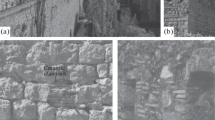The elemental chemical composition showed a heightened weight content of calcium (Ca = 5.9%) in the samples, which promotes formation of anorthite, which increases the strength of articles, and a heightened weight content of carbon (C = 14.79%) attests the introduction of fuel into the green part body. The heightened weight content of fuel in the green body promotes uniform sintering of the ceramic inside the sample. A heightened weight content of iron (Fe = 2.98%) and alkali (R2O = Na2O + K2O = 2.57%) in the sample will promote formation of a liquid phase at 950°C. X-ray phase analysis was confirmed by elemental analysis indicating that the heightened calcium content promotes the formation of anorthite.




Similar content being viewed by others
References
E. S. Abdrakhimova and V. Z. Abdrakhimov, “Chemical, phase compositions and porosity structure of the plinth brick of the White Tower (Greece) of age greater than 450 yr,” Steklo Keram., No. 4, 40 – 43 (2019); E. S. Abdrakhimova and V. Z. Abdrakhimov, “Chemical, phase compositions and porosity structure of the plinth brick of the White Tower (Greece) of age greater than 450 yr,” Glass Ceram., 76(3 – 4), 152 – 154 (2019).
V. Z. Abdrakhimov and E. S. Abdrakhimova, “Interrelation of the phase composition and durability of more than 800 year old brick for the example of the Kazan Kremlin,” Steklo Keram., No. 2, 34 – 38 (2015); V. Z. Abdrakhimov and E. S. Abdrakhimova, “interrelation of the phase composition and durability of more than 800 year old brick for the example of the Kazan Kremlin,” Glass Ceram., 72(1 – 2), 71 – 75 (2015);.
V. Z. Abdrakhimov, “Relation between the phase composition and durability of ceramic brick older than 600 yr at the Ipat’evskii monastery,” Steklo Keram., No. 3, 29 – 32 (2013); “Relation between the phase composition and durability of ceramic brick older than 600 yr at the Ipat’evskii monastery,” Glass Ceram., 70(3 – 4), 100 – 103 (2013).
V. F. Pavlov, Physicochemical Principles of Firing of Building Ceramic Products [in Russian], Stroiizdat, Moscow (1977).
V. F. Pavlov and I. V. Meshcheryakova, “Effect of adding iron-containing fusible clays on the change in the phase composition and properties of acid-resistant materials,” in: Proceedings of the NIIstroikeramika, Development of Building Materials Technology [in Russian], Moscow (1981), pp. 109 – 115.
T. I. Litvinova, V. P. Pirozhkova, and A. K. Petrov, Petrography of Non-Metallic Inclusions [in Russian], Metallurgiya, Moscow (1972). 7. B. I. Vinogradov, Petrography of Artificial Porous Aggregates [in Russian], Stroiizdat, Moscow (1972).
S. T. Suleimenov, Physicochemical Structure Formation Process in Building Materials and Mineral Waste Industry [in Russian], Manuskript, Moscow (1996).
S. Zh. Saibulatov, “Investigation of the effect of the composition of ashes on phase transformations in ash-ceramic,” Kompl. Isp. Mineral. Syr’ya, No. 11, 78 – 81 (1985).
S. Zh. Saibulatov, E. S. Abdrakhimova, V. Z. Abdrakhimov, and D. V. Abdrakhimov, “Phase transformations during roasting of an ash-clay mixture,” Vest. VKTU, No. 1, 133 – 136 (2000).
V. F. Pavlov, “Investigation of reactions occurring during firing of bodies based on kaolin clays with the addition of calcium, sodium, and potassium carbonates,” Tr. NIIstroikeramiki, No. 46, 53 – 75 (1981)
D. S. Belyankin, B. V. Ivanov, and V. V. Lapin, Petrography of Technical Stone [in Russian], Izd. Akad. Nauk SSSR, Moscow (1952).
I. S. Kainarskii and N. G. Orlova, Physicochemical Principles of Ceramics [in Russian], Nauka, Moscow (1956).
V. F. Pavlov, “Features of the conversion of silica present in clays,” Tr. NIIstroikeramiki, No. 38, 3 – 11 (1973).
E. S. Abdrakhimova, A. V. Abdrakhimov, and V. Z. Abdrakhimov, “Polymorphic transformations of SiO2 in clay materials of various chemical and mineralogical composition,” Materialovedenie, No. 7, 35 – 41 (2002).
G. V. Kukolev, Chemistry of Silicon and Physical-Chemistry of Silicates [in Russian], Vysshaya Shkola, Moscow (1966).
V. P. Petrov, E. D. Belyankina, B. Z. Chistyakov, and V. V. Kozyrev, Wollastonite [in Russian], Nauka, Moscow (1982).
Author information
Authors and Affiliations
Corresponding author
Additional information
Translated from Steklo i Keramika, No. 1, pp. 37 – 41, January, 2020.
Rights and permissions
About this article
Cite this article
Abdrakhimova, E.S., Abdrakhimov, V.Z. Interrelation of the Phase and Chemical Compositions with the Longevity of the Ceramic Material of the > 600 yr Old Barcelona Catholic Cathedral. Glass Ceram 77, 33–36 (2020). https://doi.org/10.1007/s10717-020-00232-5
Published:
Issue Date:
DOI: https://doi.org/10.1007/s10717-020-00232-5




